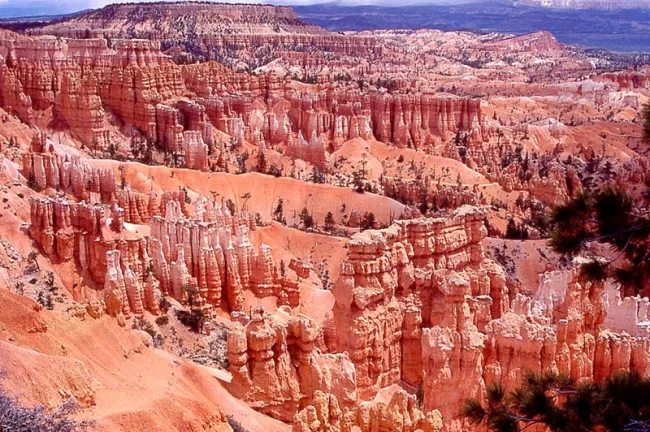
Bryce Canyon National Park, located in southwestern Utah, is renowned for its unique geological formations, particularly its vibrant red-orange hoodoos—tall, thin spires of rock that rise dramatically from the canyon floor. Although it's named "canyon," Bryce is actually a series of natural amphitheaters carved out of the eastern edge of the Paunsaugunt Plateau. With elevations ranging from 8,000 to 9,000 feet, the park offers stunning panoramic views, diverse ecosystems, and a chance to experience the solitude of the desert.
History of the Park
Bryce Canyon's history is rich with both natural and cultural significance. The region has been inhabited for thousands of years, initially by Native American groups such as the Ancestral Puebloans and the Paiute. In the late 1800s, Mormon settlers arrived in the area, with Ebenezer Bryce being one of the prominent figures. Bryce homesteaded in the area, and his name eventually became synonymous with the spectacular formations, leading to the park's name.
Bryce Canyon National Park was officially established on February 25, 1928. The park’s establishment was part of a broader movement to preserve unique geological features in the United States, and Bryce Canyon quickly gained popularity as a tourist destination.
Main Features
Bryce Canyon's standout feature is its collection of hoodoos, formed by the forces of weathering and erosion over millions of years. The park also boasts stunning plateaus, forested areas, and a diverse array of wildlife, including mule deer, foxes, and over 200 species of birds.
Key areas of interest include:
- Bryce Amphitheater: The most famous section of the park, filled with thousands of hoodoos.
- Sunset Point: Offering breathtaking views, especially during sunrise and sunset.
- Rainbow Point: The highest point in the park, providing expansive views of southern Utah.
- Thor's Hammer: One of the most photographed hoodoos in the park.
Types of Trails
Bryce Canyon offers a variety of trails that cater to all skill levels:
- Easy Trails: Rim Trail (between Sunrise and Sunset Points), Mossy Cave Trail.
- Moderate Trails: Navajo Loop Trail, Queen's Garden Trail.
- Strenuous Trails: Fairyland Loop, Peekaboo Loop, Bryce Point to Paria View.
Most of the trails offer spectacular views of the hoodoos, plateaus, and other natural formations, allowing visitors to experience the beauty of Bryce Canyon up close.
Crowd Expectations and Annual Visitors
Bryce Canyon National Park is popular year-round, with peak visitation occurring from May to September. The park receives approximately 2.5 million visitors annually. During peak months, expect crowded conditions at popular viewpoints and along the easier trails. To avoid the crowds, early morning or late afternoon hikes are recommended. Winter visits provide a quieter experience, with the added beauty of snow contrasting against the red rock formations.
Accessibility for Seniors
Bryce Canyon is senior-friendly, with several services catering to older visitors. The park provides a shuttle system that makes stops at major viewpoints, reducing the need for walking. Several trails, such as the Rim Trail between Sunrise and Sunset Points, are easy walks with minimal elevation changes. Benches are strategically placed at viewpoints to allow for resting.
Accessibility for Wheelchairs
Bryce Canyon strives to be accessible for all visitors. The Visitor Center and several viewpoints, including Sunrise Point and Sunset Point, are wheelchair accessible. The paved section of the Rim Trail between Sunset Point and Sunrise Point offers accessible views of the canyon. Additionally, the park's shuttle system accommodates wheelchairs, providing easy access to key areas.
Park Amenities
- Visitor Center: The Bryce Canyon Visitor Center provides exhibits on the geology and history of the park, along with ranger-led programs, a gift shop, and restrooms.
- Dining: Bryce Canyon Lodge offers a dining room with classic American fare.
- Shuttle System: The park operates a free shuttle service from mid-April to mid-October, reducing traffic congestion and providing convenient access to major sites.
Camping Facilities
Bryce Canyon has two campgrounds: North Campground and Sunset Campground. Both offer tent and RV sites, with North Campground open year-round, weather permitting. Reservations are recommended during peak seasons. The campgrounds provide picnic tables, fire rings, and restrooms, but no hookups for RVs.
Access to Lodging
For visitors preferring more comfortable accommodations, Bryce Canyon Lodge offers historic cabins and lodge rooms within the park. Additionally, nearby towns such as Bryce Canyon City provide a range of lodging options, including motels, inns, and vacation rentals.
Pet-Friendliness
Pets are allowed in Bryce Canyon National Park but are limited to paved surfaces, campgrounds, and parking areas. Pets must be on a leash no longer than six feet at all times. Pets are not permitted on unpaved trails or in public buildings, which limits their access within the park. Nearby areas outside the park, such as Dixie National Forest, offer more pet-friendly hiking opportunities.
Best Months to Visit
The best months to visit Bryce Canyon are from May to September, when the weather is warm and the park is fully accessible. However, these are also the busiest months. For those seeking a quieter experience, late April and early October provide milder weather and fewer crowds. Winter is a magical time in Bryce Canyon, with snow highlighting the park's red rock features, but visitors should be prepared for cold temperatures and potential trail closures.
Conclusion
Bryce Canyon National Park is a must-visit destination for anyone interested in geology, stunning natural landscapes, and outdoor adventure. Whether you're hiking among the hoodoos, watching a sunrise over the amphitheater, or simply enjoying the serenity of the high desert, Bryce Canyon offers unforgettable experiences for all. With its wide range of accessible trails, amenities, and scenic vistas, this park welcomes visitors of all ages and abilities.



